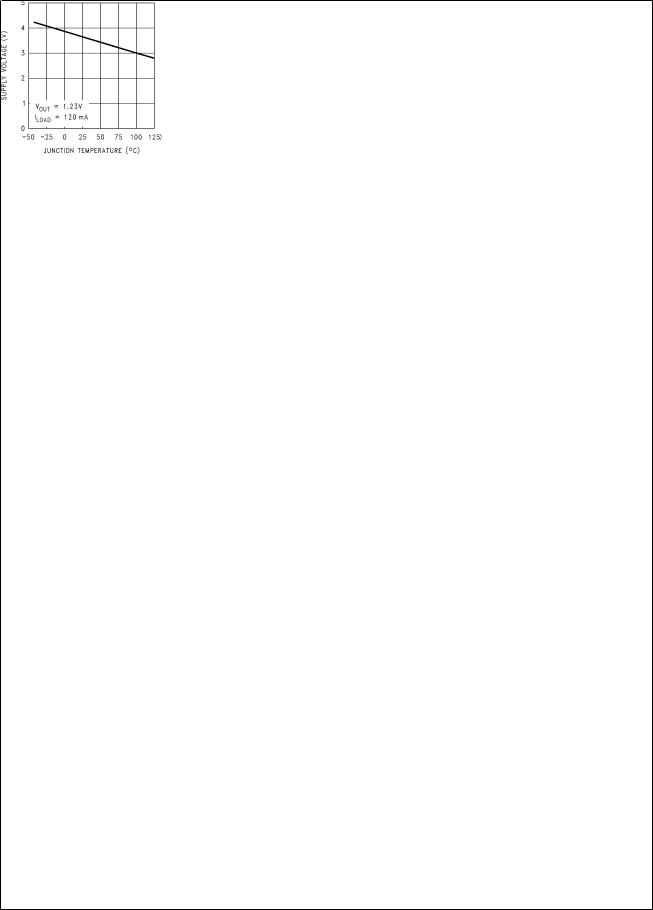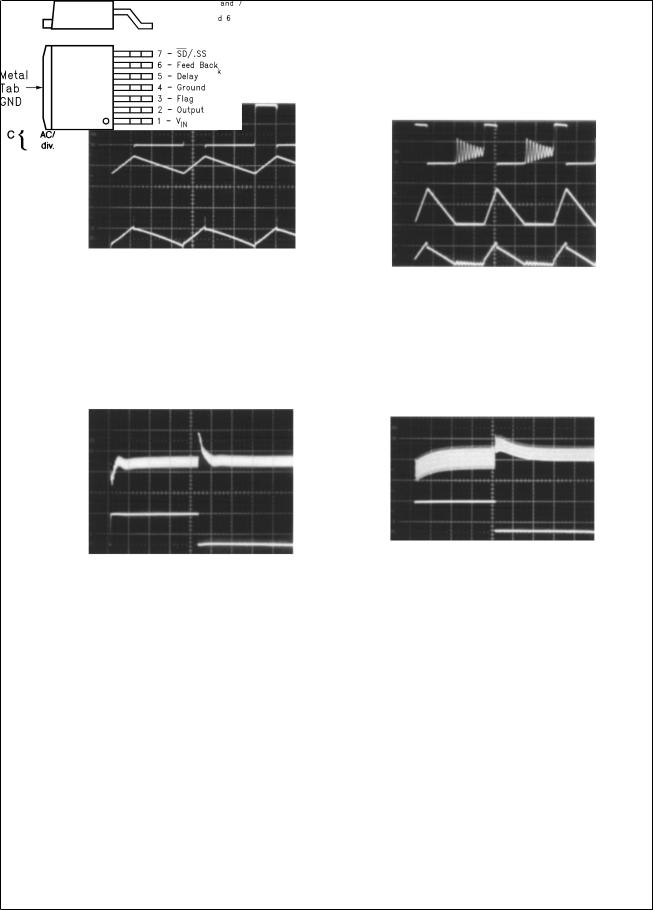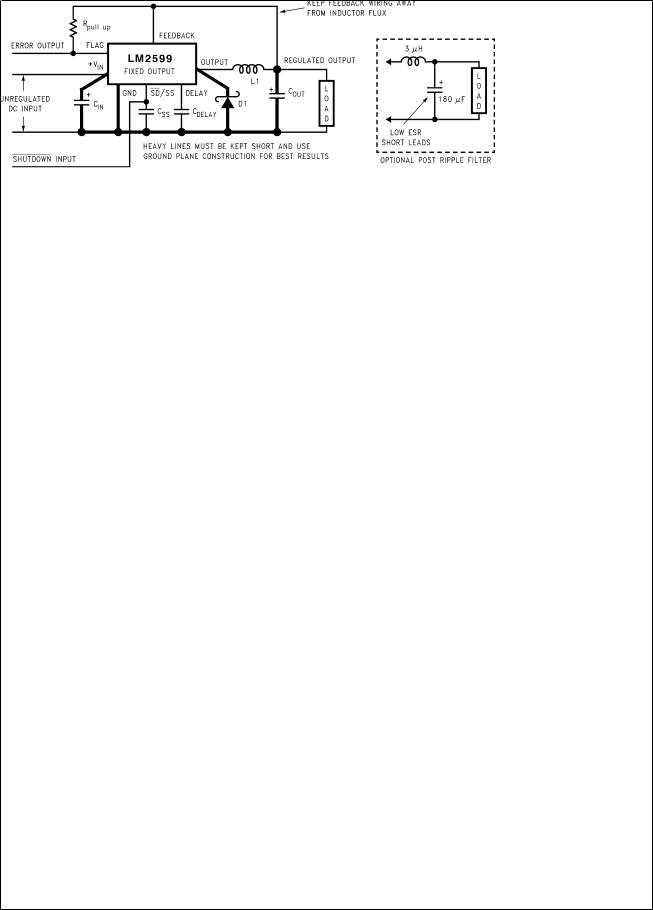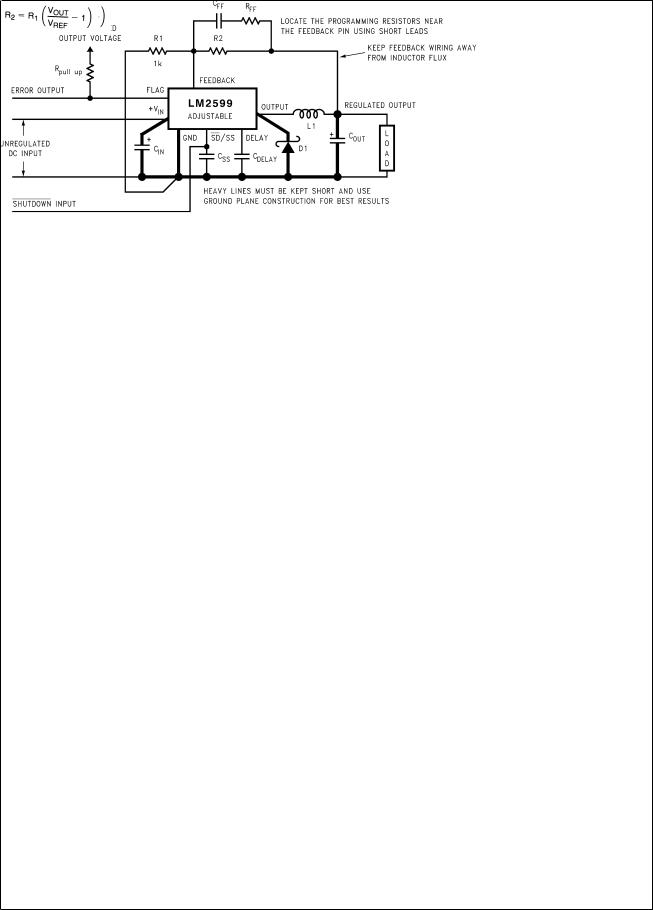NSC LM2599T-12, LM2599SX-ADJ, LM2599SX-5.0, LM2599SX-3.3, LM2599SX-12 Datasheet
...
April 1998
LM2599
SIMPLE SWITCHER® Power Converter 150 kHz 3A Step-Down Voltage Regulator, with Features
General Description
The LM2599 series of regulators are monolithic integrated circuits that provide all the active functions for a step-down (buck) switching regulator, capable of driving a 3A load with excellent line and load regulation. These devices are available in fixed output voltages of 3.3V, 5V, 12V, and an adjustable output version.
This series of switching regulators is similar to the LM2596 series, with additional supervisory and performance features added.
Requiring a minimum number of external components, these regulators are simple to use and include internal frequency compensation², improved line and load specifications, fixed-frequency oscillator, Shutdown/Soft-start, error flag delay and error flag output.
The LM2599 series operates at a switching frequency of 150 kHz thus allowing smaller sized filter components than what would be needed with lower frequency switching regulators. Available in a standard 7-lead TO-220 package with several different lead bend options, and a 7-lead TO-263 Surface mount package.
A standard series of inductors (both through hole and surface mount types) are available from several different manufacturers optimized for use with the LM2599 series. This feature greatly simplifies the design of switch-mode power supplies.
Other features include a guaranteed ±4% tolerance on output voltage under all conditions of input voltage and output load conditions, and ±15% on the oscillator frequency. External shutdown is included, featuring typically 80 µA
standby current. Self protection features include a two stage current limit for the output switch and an over temperature shutdown for complete protection under fault conditions.
Features
n3.3V, 5V, 12V, and adjustable output versions
nAdjustable version output voltage range, 1.2V to 37V
±4% max over line and load conditions
nGuaranteed 3A output current
nAvailable in 7-pin TO-220 and TO-263 (surface mount) Package
nInput voltage range up to 40V
n150 kHz fixed frequency internal oscillator
nShutdown/Soft-start
nOut of regulation error flag
nError output delay
nLow power standby mode, IQ typically 80 µA
nHigh Efficiency
nUses readily available standard inductors
nThermal shutdown and current limit protection
Applications
nSimple high-efficiency step-down (buck) regulator
nEfficient pre-regulator for linear regulators
nOn-card switching regulators
nPositive to Negative converter
Note: ² Patent Number 5,382,918.
Typical Application (Fixed Output Voltage Versions)
DS012582-1
SIMPLE SWITCHER® and Switchers Made Simple® are registered trademarks of National Semiconductor Corporation.
with Regulator, Voltage Down-Step 3A kHz 150 Converter Power SWITCHER SIMPLE LM2599
Features
© 2000 National Semiconductor Corporation |
DS012582 |
www.national.com |

LM2599
Absolute Maximum Ratings (Note 1)
If Military/Aerospace specified devices are required, please contact the National Semiconductor Sales Office/ Distributors for availability and specifications.
Maximum Supply Voltage (VIN) |
|
45V |
|
SD |
/SS Pin Input Voltage (Note 2) |
|
6V |
Delay Pin Voltage (Note 2) |
|
1.5V |
|
Flag Pin Voltage |
−0.3 |
≤ V ≤45V |
|
Feedback Pin Voltage |
−0.3 |
≤ V ≤+25V |
|
Output Voltage to Ground |
|
|
|
(Steady State) |
|
−1V |
|
Power Dissipation |
Internally limited |
||
Storage Temperature Range |
−65ÊC to +150ÊC |
||
ESD Susceptibility |
|
Human Body Model (Note 3) |
2 kV |
Lead Temperature |
|
S Package |
|
Vapor Phase (60 sec.) |
+215ÊC |
Infrared (10 sec.) |
+245ÊC |
T Package (Soldering, 10 sec.) |
+260ÊC |
Maximum Junction Temperature |
+150ÊC |
Operating Conditions
Temperature Range |
−40ÊC ≤ TJ ≤ +125ÊC |
Supply Voltage |
4.5V to 40V |
LM2599-3.3
Electrical Characteristics
Specifications with standard type face are for TJ = 25ÊC, and those with boldface type apply over full Operating Temperature Range.
Symbol |
Parameter |
Conditions |
LM2599-3.3 |
Units |
|
|
|
|
|
|
(Limits) |
|
|
|
Typ |
Limit |
|
|
|
|
|
||
|
|
|
(Note 4) |
(Note 5) |
|
|
|
|
|
|
|
SYSTEM PARAMETERS (Note 6) Test Circuit Figure 1 |
|
|
|
||
|
|
|
|
|
|
VOUT |
Output Voltage |
4.75V ≤ VIN ≤ 40V, 0.2A ≤ ILOAD ≤ 3A |
3.3 |
|
V |
|
|
|
|
3.168/3.135 |
V(min) |
|
|
|
|
3.432/3.465 |
V(max) |
|
|
|
|
|
|
η |
Efficiency |
VIN = 12V, ILOAD = 3A |
73 |
|
% |
LM2599-5.0
Electrical Characteristics
Specifications with standard type face are for TJ = 25ÊC, and those with boldface type apply over full Operating Temperature Range.
Symbol |
Parameter |
Conditions |
|
LM2599-5.0 |
Units |
|
|
|
|
|
|
|
(Limits) |
|
|
|
Typ |
|
Limit |
|
|
|
|
|
|
||
|
|
|
(Note 4) |
|
(Note 5) |
|
|
|
|
|
|
|
|
SYSTEM PARAMETERS (Note 6) Test Circuit Figure 1 |
|
|
|
|
||
|
|
|
|
|
|
|
VOUT |
Output Voltage |
7V ≤ VIN ≤ 40V, 0.2A ≤ ILOAD ≤ 3A |
5 |
|
|
V |
|
|
|
|
|
4.800/4.750 |
V(min) |
|
|
|
|
|
5.200/5.250 |
V(max) |
|
|
|
|
|
|
|
η |
Efficiency |
VIN = 12V, ILOAD = 3A |
80 |
|
|
% |
www.national.com |
2 |

LM2599-12
Electrical Characteristics
Specifications with standard type face are for TJ = 25ÊC, and those with boldface type apply over full Operating Temperature Range.
Symbol |
Parameter |
Conditions |
|
LM2599-12 |
Units |
|
|
|
|
|
|
|
(Limits) |
|
|
|
Typ |
|
Limit |
|
|
|
|
|
|
||
|
|
|
(Note 4) |
|
(Note 5) |
|
|
|
|
|
|
|
|
SYSTEM PARAMETERS (Note 6) Test Circuit Figure 1 |
|
|
|
|
||
|
|
|
|
|
|
|
VOUT |
Output Voltage |
15V ≤ VIN ≤ 40V, 0.2A ≤ ILOAD ≤ 3A |
12 |
|
|
V |
|
|
|
|
|
11.52/11.40 |
V(min) |
|
|
|
|
|
12.48/12.60 |
V(max) |
|
|
|
|
|
|
|
η |
Efficiency |
VIN = 25V, ILOAD = 3A |
90 |
|
|
% |
LM2599-ADJ
Electrical Characteristics
Specifications with standard type face are for TJ = 25ÊC, and those with boldface type apply over full Operating Temperature
Range.
Symbol |
Parameter |
Conditions |
LM2599-ADJ |
Units |
|
|
|
|
|
|
(Limits) |
|
|
|
Typ |
Limit |
|
|
|
|
|
||
|
|
|
(Note 4) |
(Note 5) |
|
|
|
|
|
|
|
SYSTEM PARAMETERS (Note 6) Test Circuit Figure 1 |
|
|
|
||
|
|
|
|
|
|
VFB |
Feedback Voltage |
4.5V ≤ VIN ≤ 40V, 0.2A ≤ ILOAD ≤ 3A |
1.230 |
|
V |
|
|
VOUT programmed for 3V. Circuit of Figure 1. |
|
1.193/1.180 |
V(min) |
|
|
|
|
1.267/1.280 |
V(max) |
|
|
|
|
|
|
η |
Efficiency |
VIN = 12V, VOUT = 3V, ILOAD = 3A |
73 |
|
% |
All Output Voltage Versions Electrical Characteristics
Specifications with standard type face are for TJ = 25ÊC, and those with boldface type apply over full Operating Temperature Range. Unless otherwise specified, VIN = 12V for the 3.3V, 5V, and Adjustable version and VIN = 24V for the 12V version. ILOAD = 500 mA
Symbol |
Parameter |
|
|
Conditions |
|
LM2599-XX |
Units |
|
|
|
|
|
|
|
|
|
(Limits) |
|
|
|
|
|
|
Typ |
Limit |
|
|
|
|
|
|
|
|
||
|
|
|
|
|
|
(Note |
(Note 5) |
|
|
|
|
|
|
|
4) |
|
|
|
|
|
|
|
|
|
|
|
DEVICE PARAMETERS |
|
|
|
|
|
|
|
|
|
|
|
|
|
|
|
|
|
Ib |
Feedback Bias Current |
|
Adjustable Version Only, VFB = 1.3V |
10 |
|
nA |
||
|
|
|
|
|
|
|
50/100 |
nA (max) |
|
|
|
|
|
|
|
|
|
fO |
Oscillator Frequency |
|
(Note 7) |
|
150 |
|
kHz |
|
|
|
|
|
|
|
|
127/110 |
kHz(min) |
|
|
|
|
|
|
|
173/173 |
kHz(max) |
|
|
|
|
|
|
|
|
|
VSAT |
Saturation Voltage |
|
IOUT = 3A (Note 8) (Note 9) |
|
1.16 |
|
V |
|
|
|
|
|
|
|
|
1.4/1.5 |
V(max) |
|
|
|
|
|
|
|
|
|
DC |
Max Duty Cycle (ON) |
|
(Note 9) |
|
100 |
|
% |
|
|
Min Duty Cycle (OFF) |
|
(Note 10) |
|
0 |
|
|
|
|
|
|
|
|
|
|
|
|
ICL |
Current Limit |
|
Peak Current, (Note 8) (Note 9) |
|
4.5 |
|
A |
|
|
|
|
|
|
|
|
3.6/3.4 |
A(min) |
|
|
|
|
|
|
|
6.9/7.5 |
A(max) |
|
|
|
|
|
|
|
|
|
IL |
Output Leakage Current |
|
(Note 8) (Note 10) (Note 11) |
Output = 0V |
|
50 |
µA(max) |
|
|
|
|
|
|
Output = −1V |
2 |
|
mA |
|
|
|
|
|
|
|
30 |
mA(max) |
|
|
|
|
|
|
|
|
|
IQ |
Operating Quiescent |
|
|
|
5 |
|
mA |
|
|
SD |
/SS Pin Open (Note 10) |
|
|
||||
|
Current |
|
|
|
|
|
10 |
mA(max) |
|
|
|
|
|
|
|
|
|
LM2599
3 |
www.national.com |

LM2599
All Output Voltage Versions
Electrical Characteristics (Continued)
Specifications with standard type face are for TJ = 25ÊC, and those with boldface type apply over full Operating Temperature Range. Unless otherwise specified, VIN = 12V for the 3.3V, 5V, and Adjustable version and VIN = 24V for the 12V version. ILOAD = 500 mA
Symbol |
Parameter |
|
|
|
|
Conditions |
LM2599-XX |
Units |
||
|
|
|
|
|
|
|
|
|
|
(Limits) |
|
|
|
|
|
|
|
|
Typ |
Limit |
|
|
|
|
|
|
|
|
|
|
||
|
|
|
|
|
|
|
|
(Note |
(Note 5) |
|
|
|
|
|
|
|
|
|
4) |
|
|
|
|
|
|
|
|
|
|
|
|
|
DEVICE PARAMETERS |
|
|
|
|
|
|
|
|
|
|
|
|
|
|
|
|
|
|
|
|
|
ISTBY |
Standby Quiescent |
|
SD |
/SS pin = 0V |
(Note 11) |
80 |
|
µA |
||
|
Current |
|
|
|
|
|
|
|
200/250 |
µA(max) |
|
|
|
|
|
|
|
|
|
|
|
θJC |
Thermal Resistance |
|
TO220 or TO263 Package, Junction to Case |
2 |
|
ÊC/W |
||||
θJA |
|
|
TO220 Package, Juncton to Ambient (Note 12) |
50 |
|
ÊC/W |
||||
θJA |
|
|
TO263 Package, Juncton to Ambient (Note 13) |
50 |
|
ÊC/W |
||||
θJA |
|
|
TO263 Package, Juncton to Ambient (Note 14) |
30 |
|
ÊC/W |
||||
θJA |
|
|
TO263 Package, Juncton to Ambient (Note 15) |
20 |
|
ÊC/W |
||||
SHUTDOWN/SOFT-START CONTROL Test Circuit of Figure 1 |
|
|
|
|
||||||
|
|
|
|
|
|
|
|
|
|
|
VSD |
Shutdown Threshold |
|
|
|
|
|
|
1.3 |
|
V |
|
Voltage |
Low, (Shutdown Mode) |
|
|
0.6 |
V(max) |
||||
|
|
High, (Soft-start Mode) |
|
|
2 |
V(min) |
||||
|
|
|
|
|
|
|
|
|
|
|
VSS |
Soft-start Voltage |
|
VOUT = 20% of Nominal Output Voltage |
2 |
|
V |
||||
|
|
|
VOUT = 100% of Nominal Output Voltage |
3 |
|
|
||||
ISD |
Shutdown Current |
|
V |
|
= 0.5V |
|
5 |
|
µA |
|
|
SHUTDOWN |
|
|
|||||||
|
|
|
|
|
|
|
|
|
10 |
µA(max) |
|
|
|
|
|
|
|
|
|
|
|
ISS |
Soft-start Current |
|
VSoft-start = 2.5V |
|
1.6 |
|
µA |
|||
|
|
|
|
|
|
|
|
|
5 |
µA(max) |
|
|
|
|
|
|
|
|
|
|
|
FLAG/DELAY CONTROL Test Circuit of Figure 1 |
|
|
|
|
||||||
|
|
|
|
|
|
|
|
|
|
|
|
Regulator Dropout Detector |
|
Low (Flag ON) |
|
96 |
|
% |
|||
|
Threshold Voltage |
|
|
|
|
|
|
|
92 |
%(min) |
|
|
|
|
|
|
|
|
|
98 |
%(max) |
|
|
|
|
|
|
|
|
|
|
|
VFSAT |
Flag Output Saturation |
|
ISINK = 3 mA |
|
0.3 |
|
V |
|||
|
Voltage |
|
VDELAY = 0.5V |
|
|
0.7/1.0 |
V(max) |
|||
IFL |
Flag Output Leakage Current |
|
VFLAG = 40V |
|
0.3 |
|
µA |
|||
|
Delay Pin Threshold |
|
|
|
|
|
|
1.25 |
|
V |
|
Voltage |
|
Low (Flag ON) |
|
|
1.21 |
V(min) |
|||
|
|
|
High (Flag OFF) and VOUT Regulated |
|
1.29 |
V(max) |
||||
|
Delay Pin Source Current |
|
VDELAY = 0.5V |
|
3 |
|
µA |
|||
|
|
|
|
|
|
|
|
|
6 |
µA(max) |
|
|
|
|
|
|
|
|
|
|
|
|
Delay Pin Saturation |
|
Low (Flag ON) |
|
55 |
|
mV |
|||
|
|
|
|
|
|
|
|
|
350/400 |
mV(max) |
|
|
|
|
|
|
|
|
|
|
|
Note 1: Absolute Maximum Ratings indicate limits beyond which damage to the device may occur. Operating Ratings indicate conditions for which the device is intended to be functional, but do not guarantee specific performance limits. For guaranteed specifications and test conditions, see the Electrical Characteristics.
Note 2: Voltage internally clamped. If clamp voltage is exceeded, limit current to a maximum of 1 mA.
Note 3: The human body model is a 100 pF capacitor discharged through a 1.5k resistor into each pin.
Note 4: Typical numbers are at 25ÊC and represent the most likely norm.
Note 5: All limits guaranteed at room temperature (standard type face) and at temperature extremes (bold type face). All room temperature limits are 100% production tested. All limits at temperature extremes are guaranteed via correlation using standard Statistical Quality Control (SQC) methods. All limits are used to calculate Average Outgoing Quality Level (AOQL).
Note 6: External components such as the catch diode, inductor, input and output capacitors can affect switching regulator system performance. When the LM2599 is used as shown in the Figure 1 test circuit, system performance will be as shown in system parameters section of Electrical Characteristics.
Note 7: The switching frequency is reduced when the second stage current limit is activated. The amount of reduction is determined by the severity of current overload.
Note 8: No diode, inductor or capacitor connected to output pin.
Note 9: Feedback pin removed from output and connected to 0V to force the output transistor switch ON.
www.national.com |
4 |

All Output Voltage Versions
Electrical Characteristics (Continued)
Note 10: Feedback pin removed from output and connected to 12V for the 3.3V, 5V, and the ADJ. version, and 15V for the 12V version, to force the output transistor switch OFF.
Note 11: VIN = 40V.
Note 12: Junction to ambient thermal resistance (no external heat sink) for the package mounted TO-220 package mounted vertically, with the leads soldered to a printed circuit board with (1 oz.) copper area of approximately 1 in2.
Note 13: Junction to ambient thermal resistance with the TO-263 package tab soldered to a single sided printed circuit board with 0.5 in2 of (1 oz.) copper area.
Note 14: Junction to ambient thermal resistance with the TO-263 package tab soldered to a single sided printed circuit board with 2.5 in2 of (1 oz.) copper area.
Note 15: Junction to ambient thermal resistance with the TO-263 package tab soldered to a double sided printed circuit board with 3 in2 of (1 oz.) copper area on the LM2599S side of the board, and approximately 16 in2 of copper on the other side of the p-c board. See application hints in this data sheet and the thermal model in Switchers Made Simple version 4.2.1 (or later) software.
Typical Performance Characteristics (Circuit of Figure 1)
Normalized |
Line Regulation |
Efficiency |
Output Voltage |
|
|
|
DS012582-3 |
DS012582-4 |
|
DS012582-2 |
|
Switch Saturation |
Switch Current Limit |
Dropout Voltage |
Voltage |
|
|
|
DS012582-6 |
DS012582-7 |
|
DS012582-5 |
|
Operating |
Shutdown |
Minimum Operating |
Quiescent Current |
Quiescent Current |
Supply Voltage |
DS012582-8 |
DS012582-9 |
DS012582-10 |
|
|
LM2599
5 |
www.national.com |

LM2599
Typical Performance Characteristics (Circuit of Figure 1) (Continued)
Feedback Pin |
Flag Saturation |
Switching Frequency |
Bias Current |
Voltage |
|
DS012582-13
DS012582-11 |
DS012582-12 |
|
Soft-start |
Shutdown /Soft-start |
Daisy Pin Current |
|
Current |
|
|
DS012582-14 |
||
|
|
|
DS012582-16 |
|
|
DS012582-15 |
|
Soft-start Response |
|
|
|
Shutdown/Soft-start |
|||
|
Threshold Voltage |
||
DS012582-18
DS012582-53
www.national.com |
6 |

Typical Performance Characteristics (Circuit of Figure 1) (Continued)
Continuous Mode Switching Waveforms |
|
VIN = 20V, VOUT = 5V, ILOAD = 2A |
Discontinuous Mode Switching Waveforms |
L = 32 µH, C OUT = 220 µF, C OUT ESR = 50 mΩ |
VIN = 20V, VOUT = 5V, ILOAD = 500 mA |
|
L = 10 µH, C OUT = 330 µF, C OUT ESR = 45 mΩ |
DS012582-20
A:Output Pin Voltage, 10V/div.
B:Inductor Current 1A/div.
C:Output Ripple Voltage, 50 mV/div.
Horizontal Time Base: 2 µs/div.
Load Transient Response for Continuous Mode
VIN = 20V, VOUT = 5V, ILOAD = 500 mA to 2A
L = 32 µH, C OUT = 220 µF, C OUT ESR = 50 mΩ
DS012582-21
A:Output Voltage, 100 mV/div. (AC)
B:500 mA to 2A Load Pulse
Horizontal Time Base: 50 µs/div.
DS012582-19
A:Output Pin Voltage, 10V/div.
B:Inductor Current 0.5A/div.
C:Output Ripple Voltage, 100 mV/div.
Horizontal Time Base: 2 µs/div.
Load Transient Response for Discontinuous Mode
VIN = 20V, VOUT = 5V, ILOAD = 500 mA to 2A
L = 10 µH, C OUT = 330 µF, C OUT ESR = 45 mΩ
DS012582-22
A:Output Voltage, 100 mV/div. (AC)
B:500 mA to 2A Load Pulse
Horizontal Time Base: 200 µs/div.
Connection Diagrams and Order Information
Bent and Staggered Leads, Through Hole Package
7-Lead TO-220 (T) Surface Mount Package 7-Lead TO-263 (S)
DS012582-50 |
|
|
Order Number LM2599T-3.3, LM2599T-5.0, |
DS012582-23 |
|
Order Number LM2599S-3.3, LM2599S-5.0, |
||
LM2599T-12 or LM2599T-ADJ |
||
LM2599S-12 or LM2599S-ADJ |
||
See NS Package Number TA07B |
||
See NS Package Number TS7B |
||
|
LM2599
7 |
www.national.com |

LM2599
Test Circuit and Layout Guidelines
Fixed Output Voltage Versions
DS012582-24
Component Values shown are for VIN = 15V,
VOUT = 5V, ILOAD = 3A.
CIN |
Ð |
470 |
µF, 50V, Aluminum Electrolytic Nichicon ªPL Seriesº |
COUT |
Ð 220 µF, 25V Aluminum Electrolytic, Nichicon ªPL Seriesº |
||
D1 |
Ð |
5A, 40V Schottky Rectifier, 1N5825 |
|
L1 |
Ð |
68 µH, L38 |
|
Typical Values |
|||
CSS |
Ð |
0.1 |
µF |
CDELAY |
Ð |
0.1 µF |
|
RPull Up |
Ð |
4.7k |
|
www.national.com |
8 |

Test Circuit and Layout Guidelines (Continued)
Adjustable Output Voltage Versions
DS012582-25
where VREF = 1.23V
Select R1 to be approximately 1 kΩ, use a 1% resistor for best stability.
Component Values shown are for VIN = 20V,
VOUT = 10V, ILOAD = 3A.
CIN: Ð 470 µF, 35V, Aluminum Electrolytic Nichicon ªPL Seriesº
COUT: Ð 220 µF, 35V Aluminum Electrolytic, Nichicon ªPL Seriesº
D1 Ð 5A, 30V Schottky Rectifier, 1N5824
L1 Ð 68 µH, L38
R1 Ð 1 k Ω, 1%
R2 Ð 7.15k, 1 %
CFF Ð 3.3 nF, See Application Information Section
RFF Ð 3 k Ω, See Application Information Section
Typical Values
CSS Ð 0.1 µF
CDELAY Ð 0.1 µF
RPULL UP Ð 4.7k
FIGURE 1. Standard Test Circuits and Layout Guides
As in any switching regulator, layout is very important. Rapidly switching currents associated with wiring inductance can generate voltage transients which can cause problems. For minimal inductance and ground loops, the wires indicated by heavy lines should be wide printed circuit traces and should be kept as short as possible. For best results, external components should be located as close to the switcher lC as possible using ground plane construction or single point grounding.
If open core inductors are used, special care must be taken as to the location and positioning of this type of inductor. Allowing the inductor flux to intersect sensitive feedback, lC groundpath and COUT wiring can cause problems.
When using the adjustable version, special care must be taken as to the location of the feedback resistors and the associated wiring. Physically locate both resistors near the IC, and route the wiring away from the inductor, especially an open core type of inductor. (See application section for more information.)
LM2599
9 |
www.national.com |

LM2599
LM2599 Series Buck Regulator Design Procedure (Fixed Output)
PROCEDURE (Fixed Output Voltage Version) |
EXAMPLE (Fixed Output Voltage Version) |
|||
|
|
|
|
|
Given: |
Given: |
|
|
|
VOUT = Regulated Output Voltage (3.3V, 5V or 12V) |
VOUT = 5V |
|
|
|
VIN(max) = Maximum DC Input Voltage |
VIN(max) = 12V |
|
||
ILOAD(max) = Maximum Load Current |
ILOAD(max) = 3A |
|
||
1. Inductor Selection (L1) |
1. Inductor Selection (L1) |
|||
A. Select the correct inductor value selection guide from Fig- |
A. Use the inductor selection guide for the 5V version shown |
|||
ure 4, Figure 5, or 6. (Output voltages of 3.3V, 5V, or 12V re- |
in Figure 5. |
|
|
|
spectively.) For all other voltages, see the design procedure |
B. From the inductor value selection guide shown in Figure 5, |
|||
for the adjustable version. |
the inductance region intersected by the 12V horizontal line |
|||
B. From the inductor value selection guide, identify the induc- |
and the 3A vertical line is 33 µH, and the inductor code is |
|||
tance region intersected by the Maximum Input Voltage line |
L40. |
|
|
|
and the Maximum Load Current line. Each region is identified |
C. The inductance value required is 33 µH. From the table in |
|||
by an inductance value and an inductor code (LXX). |
Figure 8, go to the L40 line and choose an inductor part num- |
|||
|
||||
C. Select an appropriate inductor from the four manufactur- |
ber from any of the four manufacturers shown. (In most in- |
|||
er's part numbers listed in Figure 8. |
stance, both through hole and surface mount inductors are |
|||
|
available.) |
|
|
|
2. Output Capacitor Selection (COUT) |
2. Output Capacitor Selection (COUT) |
|||
A. In the majority of applications, low ESR (Equivalent Series |
A. See section on output capacitors in application infor- |
|||
Resistance) electrolytic capacitors between 82 µF and 820 |
mation section. |
|
||
µF and low ESR solid tantalum capacitors between 10 µF |
B. From the quick design component selection table shown |
|||
and 470 µF provide the best results. This capacitor should be |
in Figure 2, locate the 5V output voltage section. In the load |
|||
located close to the IC using short capacitor leads and short |
current column, choose the load current line that is closest to |
|||
copper traces. Do not use capacitors larger than 820 µF. |
||||
the current needed in your application, for this example, use |
||||
|
||||
For additional information, see section on output capaci- |
the 3A line. In the maximum input voltage column, select the |
|||
tors in application information section. |
line that covers the input voltage needed in your application, |
|||
B. To simplify the capacitor selection procedure, refer to the |
in this example, use the 15V line. Continuing on this line are |
|||
quick design component selection table shown in Figure 2. |
recommended inductors and capacitors that will provide the |
|||
This table contains different input voltages, output voltages, |
best overall performance. |
|||
|
|
|
||
and load currents, and lists various inductors and output ca- |
The capacitor list contains both through hole electrolytic and |
|||
pacitors that will provide the best design solutions. |
surface mount tantalum capacitors from four different capaci- |
|||
C. The capacitor voltage rating for electrolytic capacitors |
tor manufacturers. It is recommended that both the manufac- |
|||
should be at least 1.5 times greater than the output voltage, |
turers and the manufacturer's series that are listed in the |
|||
table be used. |
|
|||
and often much higher voltage ratings are needed to satisfy |
|
|||
|
|
|
||
the low ESR requirements for low output ripple voltage. |
In this example aluminum electrolytic capacitors from several |
|||
D. For computer aided design software, see Switchers |
different manufacturers are available with the range of ESR |
|||
Made Simple (version 4.2.1 or later). |
numbers needed. |
|
||
|
330 µF |
35V |
Panasonic HFQ Series |
|
|
330 µF |
35V |
Nichicon PL Series |
|
|
C. For a 5V output, a capacitor voltage rating at least 7.5V or |
|||
|
more is needed. But even a low ESR, switching grade, 220 |
|||
|
µF 10V aluminum electrolytic capacitor would exhibit ap- |
|||
|
proximately 225 mΩ of ESR (see the curve in Figure 16 for |
|||
|
the ESR vs voltage rating). This amount of ESR would result |
|||
|
in relatively high output ripple voltage. To reduce the ripple to |
|||
|
1% of the output voltage, or less, a capacitor with a higher |
|||
|
value or with a higher voltage rating (lower ESR) should be |
|||
|
selected. A 16V or 25V capacitor will reduce the ripple volt- |
|||
|
age by approximately half. |
|||
|
|
|
|
|
www.national.com |
10 |
